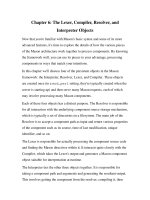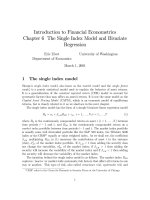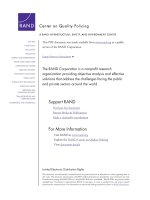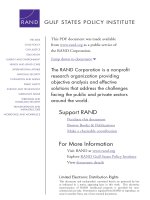HRM 5th chapter 5expanding the talent pool recruitment and careers
Bạn đang xem bản rút gọn của tài liệu. Xem và tải ngay bản đầy đủ của tài liệu tại đây (629.67 KB, 47 trang )
Expanding the Talent
Pool: Recruitment
and Careers
Managing Human Resources
Belcourt * Bohlander * Snell
Copyright © 2008 by Nelson, a division of Thomson
Canada Limited.
All rights reserved.
5th Canadian edition
PowerPoint Presentation by
Monica Belcourt, York University and
Charlie Cook, The University of West Alabama
Objectives
After studying this chapter, you should be able to:
1. Explain the advantages and disadvantages of
external recruitment.
2. Explain the advantages and disadvantages of
recruiting from within the organization.
3. Discuss how job opportunities can be inventoried
and employee potential assessed.
4. Explain how a career development program
integrates individual and organizational needs.
5. Describe the conditions that help make a career
development program successful.
6. Explain why diverse recruitment and career
Copyright
© 2008 by activities
Nelson, a are important to companies.
development
division of Thomson Canada
Ltd.
5–2
Recruiting Talent Externally
• Labour Market
Area from which applicants are to be recruited
Tight market: high employment, few available workers
Loose market: low employment, many available workers
• Factors determining the relevant labour market:
Skills and knowledge required for a job
Level of compensation offered for a job
Reluctance of job seekers to relocate
Ease of commuting to workplace
Location of job (urban or nonurban)
Copyright © 2008 by Nelson, a
division of Thomson Canada
Ltd.
5–3
Outside Sources of Recruitment
• Advertisements
• Labour unions
• Unsolicited applications
and resumes
• Public employment
agencies
• Internet recruiting
• Employee referrals
• Private employment
agencies
• Executive search firms
• Temporary help agencies
• Educational institutions
• Professional associations
Copyright © 2008 by Nelson, a
division of Thomson Canada
Ltd.
5–4
Increasing the Effectiveness of Employee
Referrals
• Up the ante
• Pay for performance
• Tailor the program
• Increase visibility
• Keep the data
• Rethink your taboos
• Widen the program
• Measure the results
Copyright © 2008 by Nelson, a
division of Thomson Canada
Ltd.
5–5
Occupational Breakdowns of Temporary Help Agency Placements
Copyright © 2008 by Nelson, a
division of Thomson Canada
Ltd.
Source: Steve Jones, “You’ve Come a Long Way, Baby: What the Staffing Industry Offers Today,” Canadian HR Reporter 14, no. 19
(November 5, 2001): 15. © Copyright Canadian HR Reporter, November 5, 2001, by permission of Carswell, Toronto, Ontario 1-800-3875164. Web: . Data supplied by Association of Canadian Search, Employment Staffing Services.
5–6
Improving the Effectiveness of External
Recruitment
Calculate
CalculateYield
YieldRatios
Ratios
Training
TrainingRecruiters
Recruiters
External
External
Recruitment
Recruitment
Realistic
RealisticJob
JobPreviews
Previews
Copyright © 2008 by Nelson, a
division of Thomson Canada
Ltd.
5–7
External Recruitment Considerations
• Yield Ratio
Percentage of applicants from a recruitment source
that make it to the next stage of the selection process.
100 resumes received, 50 found acceptable = 50% yield.
• Cost of Recruitment (per employee hired)
SC AC + AF + RB + NC
=
H
H
SC = source cost
AC = advertising costs, total monthly expenditure (example: $28,000)
AF = agency fees, total for the month (example: $19,000)
RB = referral bonuses, total paid (example: $2,300)
NC = no-cost hires, walk-ins, nonprofit agencies, etc. (example: $0)
Copyright
© 2008
by Nelson,
H = total
hires (example:
119) a
Cost
hire one employee
division
oftoThomson
Canada = $414
Ltd.
5–8
External Recruitment Considerations
• Sources of Organizational Recruiters
Professional HR recruiters
HR generalists
Work team members
• Requirements for Effective Recruiters
Knowledge of the recruited job’s requirements and of
the organization
Training as an interviewer
Personable and competent to represent the
organization
Copyright © 2008 by Nelson, a
division of Thomson Canada
Ltd.
5–9
Improving the Effectiveness of External
Recruitment (cont’d)
• Realistic Job Previews (RJP)
Informing applicants about all aspects of the job,
including both its desirable and undesirable facets.
Positive benefits of RJP
Improved employee job satisfaction
Reduced voluntary turnover
Enhanced communication through honesty and
openness
Realistic job expectations
Copyright © 2008 by Nelson, a
division of Thomson Canada
Ltd.
5–10
Recruiting Talent Internally
• Advantages of a promotion-from-within policy:
Capitalizes on past investments (recruiting, selecting,
training, and developing) in current employees.
Rewards past performance and encourages
continued commitment to the organization.
Signals to employees that similar efforts by them will
lead to promotion.
Fosters advancement of members of designated
groups within an organization.
Copyright © 2008 by Nelson, a
division of Thomson Canada
Ltd.
5–11
Recruiting Talent Internally (cont’d)
• Limitations of a promotion-from-within policy:
Current employees may lack the knowledge,
experience or skills needed for placement in the
vacant/new position.
The hazards of inbreeding of ideas and attitudes
(“employee cloning”) increase when no outsiders are
considered for hiring.
The organization has exhausted its supply of viable
internal candidates and must seek additional
employees in the external job market.
Copyright © 2008 by Nelson, a
division of Thomson Canada
Ltd.
5–12
Methods for Identifying Qualified
Candidates
• Human Resources Information Systems (HRIS)
Database systems containing the records and
qualifications of each employee that can be accessed
to identify and screen candidates for an internal job
opening.
• Job Posting and Bidding
Posting vacancy notices and maintaining lists of
employees looking for upgraded positions.
Copyright © 2008 by Nelson, a
division of Thomson Canada
Ltd.
5–13
Warning Signs of a Weak Talent “Bench”
1. It takes a long time to fill key positions.
2. Key positions can be filled only by hiring from the
outside.
3. Vacancies in key positions cannot be filled with
confidence in the abilities of those chosen for them.
4. Replacements for positions often are unsuccessful
in performing their new duties.
5. Promotions are made on the basis of whim,
favouritism, or nepotism.
Copyright © 2008 by Nelson, a
division of Thomson Canada
Ltd.
Source: Adapted from William Rothwell, Effective Succession Planning (New York: AMACOM, 2000).
Figure 5.4
5–14
Using Assessment Centres
• Assessment Centre
A process by which individuals are evaluated as they
participate in a series of situations that resemble what
they might be called on to handle on the job.
In-basket exercises
Leaderless group discussions
Role playing
Behavioural interviews
Copyright © 2008 by Nelson, a
division of Thomson Canada
Ltd.
5–15
The Goal: Matching Individual and
Organizational Needs
The
TheEmployee’s
Employee’sRole
Role
The
TheOrganization’s
Organization’sRole
Role
Career
Career
Management
Management
Individual
Individualand
and
Organizational
Goals
Nelson,
a
Organizational
Goals
Copyright © 2008 by
division of Thomson Canada
Ltd.
5–16
HR’s Role in Career Development
Copyright © 2008 by Nelson, a
division of Thomson Canada
Ltd.
Figure 5.5
5–17
The Organization’s Role: Establishing a
Favourable Context
• Management Participation
Provide top management
support
Provide collaboration
between line managers and
HR managers
Train management
personnel
• Setting Goals
Plan human resources
strategy
• Changing HR Policies
Provide for job rotation
Provide outplacement
service
• Announcing the Program
Explain its philosophy
Copyright © 2008 by Nelson, a
division of Thomson Canada
Ltd.
5–18
Balancing Individual and Organizational Needs
Copyright © 2008 by Nelson, a
division of Thomson Canada
Ltd.
Figure 5.6
5–19
Identifying Career Opportunities and
Requirements
• Competency Analysis
Measures three basic competencies for each job:
know-how, problem solving, and accountability.
• Job Progressions
The hierarchy of jobs a new employee might
experience, ranging from a starting job to jobs that
require more knowledge and/or skill.
• Career Paths
Lines of advancement in an occupational field within
an organization.
Copyright
© 2008 by Nelson, a
division of Thomson Canada
Ltd.
5–20
Typical Line of Advancement in HR Management
Copyright © 2008 by Nelson, a
division of Thomson Canada
Ltd.
Figure 5.7
5–21
Recognize Lots of Possibilities
• Promotion
A change of assignment to a job at a higher level in
the organization.
Principal criteria for determining promotions are merit,
seniority, and potential.
• Transfer
The placement of an individual in another job for
which the duties, responsibilities, status, and
remuneration are approximately equal to those of the
previous job.
Copyright © 2008 by Nelson, a
division of Thomson Canada
Ltd.
5–22
Alternative Career Moves
Copyright © 2008 by Nelson, a
division of Thomson Canada
Ltd.
5–23
Career Change Organizational Assistance
• Relocation services
Services provided to an employee who is transferred
to a new location:
Help in moving, in selling a home, in orienting to a new
culture, and/or in learning a new language.
• Outplacement services
Services provided by organizations to help terminated
employees find a new job.
Copyright © 2008 by Nelson, a
division of Thomson Canada
Ltd.
5–24
Highlights in HRM
Dual Career Tracks: Xenova System
Scientist
Senior Scientist
Section Leader
Head a
Copyright © Department
2008 by Nelson,
division of Thomson Canada
Ltd.
Research Associate
Principal Scientist
Source: Adapted from Alan Garmonsway of Xenova and Michael Wellin of Behavioral
Transformation, “Creating the Right Natural Chemistry,” People Management 1, no. 19 (September
21, 1995): 36–39.
Highlights 5.3
5–25









